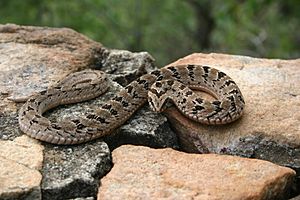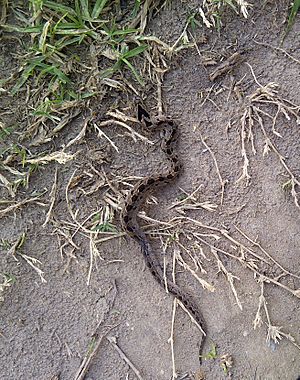Causus facts for kids
Quick facts for kids Causus |
|
|---|---|
 |
|
| Common night adder, C. rhombeatus | |
| Scientific classification |
|
| Kingdom: | Animalia |
| Phylum: | Chordata |
| Class: | Reptilia |
| Order: | Squamata |
| Suborder: | Serpentes |
| Family: | Viperidae |
| Subfamily: | Viperinae |
| Genus: | Causus Wagler, 1830 |
| Species | |
| Synonyms | |
|
|
Causus is a group of vipers found only in sub-Saharan Africa. These snakes are often called night adders. There are currently seven known types, or species, of Causus snakes. Like all other vipers, they are venomous.
Scientists once thought these snakes were very old members of the viper family. This was because of how their heads are scaled, how they lay eggs, and their round eye pupils. However, newer studies using DNA have shown this might not be true.
Contents
What Do Night Adders Look Like?
These snakes are quite sturdy. They usually do not grow longer than 1 m (3.3 ft) (about 3 feet).
Head and Scales
Most vipers have a head that looks very different from their neck. Their heads are also covered with many small scales. But Causus snakes are different. Their heads are only slightly wider than their necks. They have nine large, symmetrical scales on their heads.
Another unique feature is their eyes. Causus snakes have round pupils, not the slit-like pupils seen in many other vipers. The scale at the tip of their nose, called the rostral scale, is wide. Sometimes it can even be pointed or turned upwards.
Fangs and Venom Glands
The fangs of Causus snakes are also a bit different. They are relatively short. Even though they are short, the snakes can still move their upper jaw bones to make the fangs stand up. A small line can be seen along the fang. This line shows where the fang's groove almost closed to form a tube.
Many Causus species have very long venom glands. Unlike most vipers, where these glands are only in the head area, Causus venom glands can extend far down their neck. These glands can be up to 10 cm (about 4 inches) long. Long tubes connect these glands to their fangs.
Body Features
The body of a night adder is usually round. It can also be slightly flattened. Their scales on the back are smooth or only slightly ridged. The scales on their belly are rounded. They have a single anal plate, which is a scale covering the vent. Their tail is short. The scales under the tail can be either single or in pairs.
Inside their bodies, Causus snakes also have some special features. They have unusually long kidneys. They also have a well-developed lung that helps them breathe. Their liver also overlaps the tip of their heart.
Where Do Night Adders Live?
Causus snakes live in sub-Saharan Africa. This is the part of Africa south of the Sahara Desert.
How Do Night Adders Behave?
Even though they are called "night adders," these snakes are active both during the day and at night.
When they feel threatened, they make a loud hissing and puffing sound. They might also lift the front part of their body off the ground. They coil up and can strike powerfully. Young snakes have even been seen jumping off the ground when striking. Some night adders might flatten their necks and move forward like a small cobra. They often strike quickly and then try to glide away fast.
What Do Night Adders Eat?
Night adders mostly eat toads and frogs. If there is a lot of food, they might eat so much that they can barely swallow any more!
Reproduction and Life Cycle
All Causus species lay eggs. This is called being oviparous. Most vipers give birth to live young, so laying eggs is a less common trait for vipers. A female night adder usually lays about two dozen eggs. These eggs take about four months to hatch. When they hatch, the baby snakes are about 10–12.5 cm (4–5 in) long.
Night Adder Venom
Even though night adders have very large venom glands, they do not always use their venom to catch their food. Their venom works quickly, but often they just grab and swallow their prey instead.
The venom of Causus snakes is not as strong as the venom of some other vipers, like the puff adder. If a person is bitten, they usually only feel pain and swelling in the area. Often, special medicine called antivenom is not needed. However, some bites can be serious. In one case, a child who was bitten needed a special surgery called a fasciotomy. Some small dogs have lost limbs or even died from night adder bites. So, it is important to be careful around these snakes, especially if a large one bites a small child.
There have been no recent reports of people dying from these snake bites. Older stories of deaths might have been about different snake species, or the bites were not treated correctly.
Types of Night Adders
| Species | Taxon author | Common name | Geographic range |
|---|---|---|---|
| Causus bilineatus | Boulenger, 1905 | Two-striped night adder | Africa in Angola, Zambia, and southern DR Congo |
| Causus defilippii | (Jan, 1863) | Snouted night adder | Southeast Africa |
| Causus lichtensteinii | (Jan, 1859) | Lichtenstein's night adder | Equatorial Africa from Zambia and Cameroon to the Ivory Coast |
| Causus maculatus | (Hallowell, 1842) | West African night adder | Most of sub-Saharan Africa north of the equator |
| Causus rasmusseni | Broadley, 2014 | Angolan night adder | Zambia and Angola |
| Causus resimus | (W. Peters, 1862) | Green night adder | Most of equatorial Africa |
| Causus rhombeatusT | (Lichtenstein, 1823) | Common night adder | Sub-Saharan Africa |
T) Type species.
See also
 In Spanish: Causus para niños
In Spanish: Causus para niños


